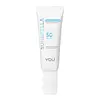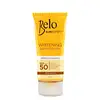What's inside
What's inside
 Key Ingredients
Key Ingredients

 Benefits
Benefits

 Concerns
Concerns

 Ingredients Side-by-side
Ingredients Side-by-side

Water
Skin ConditioningGlycerin
HumectantPropylene Glycol
HumectantPolymethyl Methacrylate
PPG-24-Glycereth-24
EmulsifyingButyl Methoxydibenzoylmethane
UV AbsorberEthylhexyl Triazone
UV AbsorberAcrylates/C10-30 Alkyl Acrylate Crosspolymer
Emulsion StabilisingAminomethyl Propanol
BufferingPhenoxyethanol
PreservativeHydroxyacetophenone
AntioxidantAllantoin
Skin ConditioningButylene Glycol
HumectantXanthan Gum
EmulsifyingDisodium EDTA
Pentylene Glycol
Skin ConditioningSodium Hyaluronate
HumectantGentiana Scabra Root Extract
Skin ConditioningPropanediol
SolventEctoin
Skin ConditioningArmillaria Mellea Extract
Skin ConditioningZea Mays Starch
AbsorbentHydrogenated Lecithin
EmulsifyingHydrolyzed Corn Starch
HumectantHydrolyzed Corn Starch Octenylsuccinate
AbsorbentLimonia Acidissima Extract
Skin ConditioningButyrospermum Parkii Butter
Skin ConditioningCocamidopropyl Dimethylamine
EmulsifyingBorago Officinalis Extract
EmollientPhenylethyl Resorcinol
AntioxidantMoringa Oleifera Seed Extract
Skin ConditioningCeramide NP
Skin ConditioningLactic Acid
Buffering1,2-Hexanediol
Skin ConditioningHydrated Silica
AbrasivePalmitoyl Tripeptide-5
Skin ConditioningCeramide As
Skin ConditioningCeramide Ng
Skin ConditioningEthylhexylglycerin
Skin ConditioningErgothioneine
AntioxidantCeramide EOP
Skin ConditioningCeramide AP
Skin ConditioningWater, Glycerin, Propylene Glycol, Polymethyl Methacrylate, PPG-24-Glycereth-24, Butyl Methoxydibenzoylmethane, Ethylhexyl Triazone, Acrylates/C10-30 Alkyl Acrylate Crosspolymer, Aminomethyl Propanol, Phenoxyethanol, Hydroxyacetophenone, Allantoin, Butylene Glycol, Xanthan Gum, Disodium EDTA, Pentylene Glycol, Sodium Hyaluronate, Gentiana Scabra Root Extract, Propanediol, Ectoin, Armillaria Mellea Extract, Zea Mays Starch, Hydrogenated Lecithin, Hydrolyzed Corn Starch, Hydrolyzed Corn Starch Octenylsuccinate, Limonia Acidissima Extract, Butyrospermum Parkii Butter, Cocamidopropyl Dimethylamine, Borago Officinalis Extract, Phenylethyl Resorcinol, Moringa Oleifera Seed Extract, Ceramide NP, Lactic Acid, 1,2-Hexanediol, Hydrated Silica, Palmitoyl Tripeptide-5, Ceramide As, Ceramide Ng, Ethylhexylglycerin, Ergothioneine, Ceramide EOP, Ceramide AP
Water
Skin ConditioningEthylhexyl Methoxycinnamate
UV AbsorberCyclotetrasiloxane
EmollientCyclopentasiloxane
EmollientNiacinamide
SmoothingCetyl Alcohol
EmollientGlyceryl Stearate
EmollientCeteareth-20
CleansingCeteareth-12
EmulsifyingCetearyl Alcohol
EmollientCetyl Palmitate
EmollientButyl Methoxydibenzoylmethane
UV AbsorberButyrospermum Parkii Butter
Skin ConditioningOctocrylene
UV AbsorberBenzyl Alcohol
PerfumingGlyceryl Caprylate
EmollientGlyceryl Undecylenate
EmollientC12-15 Alkyl Benzoate
AntimicrobialHydrogenated Dimer Dilinoleyl/Dimethylcarbonate Copolymer
Emulsion StabilisingTitanium Dioxide
Cosmetic ColorantAlumina
AbrasiveSimethicone
EmollientButylene Glycol
HumectantBee Venom
AstringentSorbitan Palmitate
EmulsifyingSorbitan Olivate
EmulsifyingCarbomer
Emulsion StabilisingTriethanolamine
BufferingBisabolol
MaskingPanthenol
Skin ConditioningTocopheryl Acetate
AntioxidantTetrasodium EDTA
Benzylidene Dimethoxydimethylindanone
Skin ProtectingCitric Acid
BufferingWater, Ethylhexyl Methoxycinnamate, Cyclotetrasiloxane, Cyclopentasiloxane, Niacinamide, Cetyl Alcohol, Glyceryl Stearate, Ceteareth-20, Ceteareth-12, Cetearyl Alcohol, Cetyl Palmitate, Butyl Methoxydibenzoylmethane, Butyrospermum Parkii Butter, Octocrylene, Benzyl Alcohol, Glyceryl Caprylate, Glyceryl Undecylenate, C12-15 Alkyl Benzoate, Hydrogenated Dimer Dilinoleyl/Dimethylcarbonate Copolymer, Titanium Dioxide, Alumina, Simethicone, Butylene Glycol, Bee Venom, Sorbitan Palmitate, Sorbitan Olivate, Carbomer, Triethanolamine, Bisabolol, Panthenol, Tocopheryl Acetate, Tetrasodium EDTA, Benzylidene Dimethoxydimethylindanone, Citric Acid
 Reviews
Reviews

Ingredients Explained
These ingredients are found in both products.
Ingredients higher up in an ingredient list are typically present in a larger amount.
Also known as Avobenzone, this ingredient is a chemical sunscreen filter that provides protection in the UV-A range.
Avobenzone is globally approved and is the most commonly used UV-A filter in the world.
Studies have found that avobenzone becomes ineffective when exposed to UV light (it is not photostable; meaning that it breaks down in sunlight). Because of this, formulations that include avobenzone will usually contain stabilizers such as octocrylene.
However, some modern formulations (looking at you, EU!) are able to stabilize avobenzone by coating the molecules.
Avobenzone does not protect against the UV-B range, so it's important to check that the sunscreen you're using contains other UV filters that do!
The highest concentration of avobenzone permitted is 3% in the US, and 5% in the EU.
Learn more about Butyl MethoxydibenzoylmethaneButylene Glycol (or BG) is used within cosmetic products for a few different reasons:
Overall, Butylene Glycol is a safe and well-rounded ingredient that works well with other ingredients.
Though this ingredient works well with most skin types, some people with sensitive skin may experience a reaction such as allergic rashes, closed comedones, or itchiness.
Learn more about Butylene GlycolThis ingredient is also known as shea butter. It is an effective skin hydrator and emollient.
Emollients help soothe and soften your skin. It does this by creating a protective film on your skin. This barrier helps trap moisture and keeps your skin hydrated. Emollients may be effective at treating dry or itchy skin.
Shea butter is rich in antioxidants. Antioxidants help fight free-radicals, or molecules that may harm the body. It is also full of fatty acids including stearic acid and linoleic acid. These acids help replenish the skin and keep skin moisturized.
While Shea Butter has an SPF rating of about 3-4, it is not a sunscreen replacement.
Shea butter may not be fungal acne safe. We recommend speaking with a professional if you have any concerns.
Learn more about Butyrospermum Parkii ButterWater. It's the most common cosmetic ingredient of all. You'll usually see it at the top of ingredient lists, meaning that it makes up the largest part of the product.
So why is it so popular? Water most often acts as a solvent - this means that it helps dissolve other ingredients into the formulation.
You'll also recognize water as that liquid we all need to stay alive. If you see this, drink a glass of water. Stay hydrated!
Learn more about Water